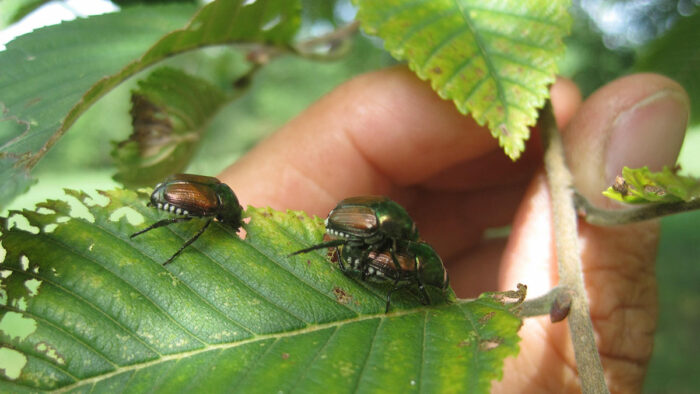
It was long thought that Japanese beetles (Popillia japonica) would not survive in our Mountain West climate; after all, they like humidity and moisture. But when they were introduced into Colorado in the early 1990s through some infected nursery stock from the Midwest, we found out otherwise. It turns out that Japanese beetles like our irrigated lawns and gardens. Consequently, they have spread up and down the front range of Colorado, especially in recent years, causing destruction along the way. Much to my dismay, I have recently started seeing them in my town of Fort Collins.
Japanese beetles at a glance
Japanese beetles are ½-inch-long scarab beetles. The adults are easily identified by their metallic green bodies and the copper-colored coverings on their wings. In Colorado, the adults emerge in late June and July and continue to live into September. Their larvae are white 1-inch-long grubs usually found curled in a C-shape. They reside in the soil and especially in lawns.

What Japanese beetles damage
The voracious beetles cause damage at both developmental stages. As larvae, they feast on the roots of lawns and other plant roots; as adults, they munch on leaves and flowers of over 300 species of plants that are found in our gardens, agricultural fields, and even some of our wild areas of native plants.

Control tactics
So how do we deal with Japanese beetles? Your approach will probably depend upon the level of infestation you have. Generally, multiple strategies are required. Here are some of the most effective ones.
- Minimize plantings of favorite foods for the adults. Also, consider reducing turf areas in your yard, which help feed the larvae. Either strategy disrupts their development cycle, at least within your own garden.
- In the early morning or in the evening, hand-pick the beetles and drop them into soapy water to drown. This is a highly effective strategy. At our botanic garden, we send volunteers out in the early morning to do this very thing, and it is helping to minimize the damage by the adult beetles.
- Reducing irrigation to lawns will minimize any egg-laying by the adult females.
- If you have chickens or any other birds, allow them to roam in the affected areas, or feed the beetles to them directly.
- Use biological controls such as parasitic nematodes or a specific strain of the bacterium Bacillus thuringiensis. These are better alternatives to traditional insecticides, which may negatively impact pollinators and other beneficial insects.
- Use Japanese beetle traps, which are sold online. Be sure to place the traps at a distance from the affected plants to draw the beetles away from their food source.
An invasive species on the move
While Japanese beetles haven’t been found in Wyoming or Utah yet, it is most likely just a matter of time as they naturally spread and move with nursery stock. The state of Idaho has had some significant success in controlling them and decreasing their populations in recent years by using traps. Other states should follow their example.
For more information on Japanese beetles, contact your local extension service or check out these resources:
—Michelle Provaznik is executive director of the Gardens on Spring Creek in Fort Collins, Colorado.
Fine Gardening Recommended Products

DeWalt Variable-Speed Cordless Reciprocating Saw with 6-Piece Saw Blade Set

Black and Decker 22-inch Cordless Hedge Trimmer

Scotts Cordless Grass-Shear/Shrub-Trimmer Combo


















Comments
Log in or create an account to post a comment.
Sign up Log in